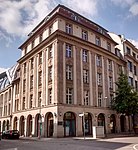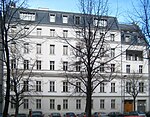Hausvogteiplatz (Berlin U-Bahn)
Berlin U-Bahn stationsBerlin U-Bahn stubsBerlin railway station stubsBuildings and structures in MitteRailway stations in Germany opened in 1908

Hausvogteiplatz is a Berlin U-Bahn station on line U2, located in Mitte. The eponymous square, former site of a bastion of the historic city fortification, was named after the Prussian aulic court and prison. In the late 19th century it had developed as a centre of Berlin's clothing industry. The station, designed by Alfred Grenander, opened on 1 October 1908 with Berlin's second U-Bahn line, running from Potsdamer Platz on the initial Stammstrecke route to Spittelmarkt. During an air raid on 3 February 1945 it was devastated by a direct bomb hit and could not be reopened until 1950.
Excerpt from the Wikipedia article Hausvogteiplatz (Berlin U-Bahn) (License: CC BY-SA 3.0, Authors, Images).Hausvogteiplatz (Berlin U-Bahn)
Hausvogteiplatz, Berlin Mitte
Geographical coordinates (GPS) Address Website Nearby Places Show on map
Geographical coordinates (GPS)
| Latitude | Longitude |
|---|---|
| N 52.513055555556 ° | E 13.396666666667 ° |
Address
Denkzeichen Modezentrum Hausvogteiplatz
Hausvogteiplatz
10117 Berlin, Mitte
Germany
Open on Google Maps










